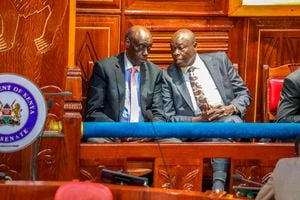Degraded Kiu Wetland shows signs of recovery

Cyrus Sakai Mutiso, a neighbour of Kiu Wetland in Makueni County and the chairman of FRiends of Kiu, a lobby which champions the restoration of the wetland, plants a bamboo seedling at the vast wetland on November 3, 2023. The government is working closely with the local community to restore the vast wetland.
What you need to know:
- The Kiu community has stepped up efforts to grow thousands of indigenous trees around the sprawling wetland.
- However, drought and destruction of the seedlings by livestock have derailed conservation efforts.
A decade ago, Cyrus Mutiso watched in disbelief as River Makindu dried up completely. The permanent river emanating from the sprawling Kiu Wetland in the area served one of the driest regions in Makueni County.
It supported a vibrant horticulture industry, throwing a lifeline to tens of residents. The drying up of the river therefore ushered hopelessness in the area by shattering hundreds of livelihoods.
“Kiu area was a source of hope until 2013. It was home to fresh fish, sugarcane and assorted vegetables that were readily available all year round. I sold vegetables worth Sh200,000 weekly to exporters. All this ended when River Makindu dried up,” said Mr Mutiso, who is the chairman of Friends of Kiu, a community-based organisation that champions environmental well-being.
“We made a mistake by encroaching on the wetland. We have set out to correct the mess, which has made farming in this area untenable,” Mr Mutiso said. A section of the local community believes the problem is aggravated by over-abstraction of the wetland, which supplies Makindu, Kiunduani, Kibarani, Mbui Nzau and Kibwezi townships with water.
The Kiu community has stepped up efforts to grow thousands of indigenous trees around the sprawling wetland. However, drought and destruction of the seedlings by livestock have derailed conservation efforts.

A team of Kenya Forest Service forest guards patrol a section of Kiu Wetland in Makueni County on February 3, 2023. The government is working closely with the local community to restore the vast wetland.
The Kiu community has also constructed sand dams across River Makindu in a bid to conserve the wetland and raise the water table in the region.
Sensing danger, the farming community that depended on River Makindu for a living sunk shallow wells along the riverbed in a bid to sustain their livelihoods. A majority of the farmers gave up farming due to increased cost of production caused mainly by the increasing cost of pumping water from the deep wells to the farmlands using diesel pumps.
But all is not lost. Mr Mutiso is excited as a section of River Makindu is regaining its lost glory. “We have not seen this amount of water here in the last 10 years. Our efforts are bearing fruit,” said Kyee Mbatha, an environmentalist. Kenya Forest Service (KFS) has fenced off a section of the Kiu Wetland to protect 120,000 seedlings.
Environment Cabinet Secretary Soipan Tuya recently said: “We’re going to recruit a green army of locals to protect the wetland.” According to the head of KWS Alex Lermakoko, it will take at least five years for Kiu Wetland to recover fully. “Within five years, Kiu Wetlands will start experiencing regeneration of natural tree species as it will have enough seeds,” said Mr Lemarkoko.
On November 13, 2023 during the national tree planting day, President William Ruto ordered the relevant government authorities to ensure speedy restoration of Kiu Wetlands and nine other wetlands in the region through a Kenya gazette notice. The wetlands are Kiboko, Umani, Kibwezi, Kwa Kyai, Thange, Kambu, Mang’elete, Ngai Ndethya and Mzima.
The region has 10 wetlands and only two are protected. Due to wetland destruction, the number of rivers in the region has reduced to one after 22 of them dried up over the years. Dr Ruto blamed this on climate change and human activities.
“We have cut down trees and encroached on the wetlands,” said Dr Ruto. Climate change experts say the restoration of wetlands is key in combating drought and boosting food production. “Before we plan to address food security, we need to plan to conserve the environment so that we get rains and enough water to grow crops. Environmental conservation is key in our plan to lower the cost of living through food production,” said Dr Ruto.
Meanwhile, the National Environmental Management Authority (Nema) has set off the process of gazetting Kiu Wetland. Ms Soipan’s latest declaration that the government is out to possess all wetlands has sent shivers down the spines of those who have encroached on the sources of water.
“We have been coexisting with the wetlands for years. The government should consider involving us in conserving the wetlands instead of threatening to kick us out. The government should give us options that will help us continue conserving the catchment area as we have done over the years,” said Ibrahim Makwata, a resident of the area.
The head of Nema in Eastern region Marian Kioko appealed for calm among the residents, saying the government was determined to strike an amicable balance between their concerns and the push for conservation.





